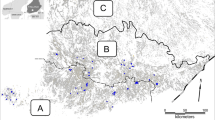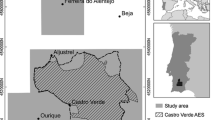Abstract
Agricultural intensification has fragmented rangelands in the Great Plains, which has contributed to uniform and homogeneous landscapes and decreased biodiversity. Alternative land management practices involving fire-grazing interactions can help maintain biodiversity without affecting livestock productivity. A survey was designed to understand the factors that influence preferences among the general population towards grassland landscape heterogeneity. Given the ordinal nature of survey responses, requisite data were analyzed using a generalized ordinal logit model. Results suggested that respondents who valued open space and those who recognized a need for a varying mix of uniform grasses and grasslands preferred landscape heterogeneity. Female respondents were about two times as likely to prefer heterogeneous landscapes compared to male respondents. In contrast, population groups that preferred wildlife habitat did not desire heterogeneous landscapes. Results suggest the need for extension and outreach activities to educate certain segments of the general population regarding benefits of alternative management practices that support landscape heterogeneity in the Great Plains.
Similar content being viewed by others
Notes
The original survey is available from corresponding author upon request.
References
Allred BW, Fuhlendorf SD, Engle DM, Elmore RD (2011) Ungulate preference for burned patches reveals strength of fire–grazing interaction. Ecol Evol 1:132–144
Anderson J (2012) Influence of Habitat Heterogeneity on Small Mammals in the Central Platte River Valley. Fort Hays State University, NE
Anderson R, Fuhlendorf SD, Engle DM (2006) Soil nitrogen availability in tallgrass prairie under the fire–grazing interaction. Rangel Ecol Manag 59:625–631
Becerra TA, Engle DM, Elmore RD, Fuhlendorf SD (2013) Contrasting preference for grassland landscapes among population groups in the central and southern Great Plains. Rangel Ecol Manag 66:529–538
Becerra TA, Engle DM, Fuhlendorf SD, Elmore RD (2017) Preference for grassland heterogeneity: implications for biodiversity in the Great Plains. Soc Nat Resour 30: 601–612
Benton TG, Vickery JA, Wilson JD (2003) Farmland biodiversity: is habitat heterogeneity the key? Trends Ecol Evol 18:182–188
Bourassa SC (1990) A paradigm for landscape aesthetics. Environ Behav 22:787–812
Brant R (1990) Assessing proportionality in the proportional odds model for ordinal logistic regression. Biometrics 46: 1171–1178
Brunson MW, Huntsinger L (2008) Ranching as a conservation strategy: can old ranchers save the new west? Rangel Ecol Manag 61:137–147
Buijs AE, Elands BH, Langers F (2009) No wilderness for immigrants: cultural differences in images of nature and landscape preferences. Landsc Urban Plan 91:113–123
Chapin III FS, Matson PA, Vitousek P (2011) Principles of terrestrial ecosystem ecology. Springer Science and Business Media, New York, USA
Coppedge BR, Engle DM, Fuhlendorf SD, Masters RE, Gregory MS (2001) Landscape cover type and pattern dynamics in fragmented southern Great Plains grasslands. USA Landsc Ecol 16:677–690
Dearden P (1984) Factors influencing landscape preferences: an empirical investigation. Lands Plan 11:293–306
Derner JD, Lauenroth WK, Stapp P, Augustine DJ (2009) Livestock as ecosystem engineers for grassland bird habitat in the western Great Plains of North America. Rangel Ecol Manag 62:111–118
Dillman DA (2000) Mail and internet surveys: The tailored design method, vol 2. Wiley, New York
Fuhlendorf SD, Engle DM (2001) Restoring heterogeneity on rangelands: ecosystem management based on evolutionary grazing patterns. Bioscience 51:625–632
Fuhlendorf SD, Harrell WC, Engle DM, Hamilton RG, Davis CA, Leslie DM (2006) Should heterogeneity be the basis for conservation? Grassland bird response to fire and grazing. Ecol Appl 16:1706–1716
Fuhlendorf SD, Townsend DE, Elmore RD, Engle DM (2010) Pyric-herbivory to promote rangeland heterogeneity: evidence from small mammal communities. Rangel Ecol Manag 63:670–678
Greene WH (2008) Econometric Analysis. Prentice-Hall International Inc, New Jersey
Haslem A, Bennett AF (2008) Birds in agricultural mosaics: the influence of landscape pattern and countryside heterogeneity. Ecol Appl 18:185–196
Joshi O, Grebner DL, Hussain A, Grado SC (2013) Landowner knowledge and willingness to supply woody biomass for wood-based bioenergy: sample selection approach. J Forest Econ 19:97–109
Katayama N et al. (2014) Landscape heterogeneity–biodiversity relationship: effect of range size. PLoS One 9:e93359
Klaiber HA, Phaneuf DJ (2009) Do sorting and heterogeneity matter for open space policy analysis? An empirical comparison of hedonic and sorting models. Amer J Agr Econ 91:1312–1318
Limb RF, Fuhlendorf SD, Engle DM, Weir JR, Elmore RD, Bidwell TG (2011) Pyric–herbivory and cattle performance in grassland ecosystems. Rangel Ecol Manag 64:659–663
Long JS, Freese J (2006) Regression models for categorical dependent variables using Stata. Stata press, College Station Texas
McFadden D (1974) The measurement of urban travel demand. J Public Econ 3:303–328
Morton LW, Regen E, Engle DM, Miller JR, Harr RN (2010) Perceptions of landowners concerning conservation, grazing, fire, and eastern redcedar management in tallgrass prairie. Rangel Ecol Manag 63:645–654
Murphy A (1996) Simple LM tests of mis-specification for ordered logit models. Econ Lett 52:137–141
Poudyal NC, Hodges DG (2009) Factors influencing landowner interest in managing wildlife and avian habitat on private forestland. Hum Dimens Wildl 14:240–250
Raymond CM, Brown G, Weber D (2010) The measurement of place attachment: personal, community, and environmental connections. J Environ Psychol 30:422–434
Saud P, Wang J, Sharma BD, Liu W (2015) Carbon impacts of hardwood lumber processing in the northeastern United States. Can J For Res 45:1699–1710
Scasta JD, Engle DM, Talley JL, Weir JR, Fuhlendorf SD, Debinski DM (2015) Drought influences control of parasitic flies of cattle on pastures managed with patch-burn grazing. Rangeland Ecol Manage 68:290–297
Soliva R, Bolliger J, Hunziker M (2010) Differences in preferences towards potential future landscapes in the Swiss Alps. Lands Res 35:671–696
Sorice M, Kreuter U, Wilcox B, Fox W (2012) Classifying land-ownership motivations in central, Texas, USA: a first step in understanding drivers of large-scale land cover change. J Arid Environ 80:56–64
Sorice MG, Kreuter UP, Wilcox BP, Fox WE (2014) Changing landowners, changing ecosystem? Landownership motivations as drivers of land management practices. J Environ Manage 133:144–152
Strumse E (1994) Perceptual dimensions in the visual preferences for agrarian landscapes in western Norway. J Environ Psychol 14:281–292
Tempesta T (2010) The perception of agrarian historical landscapes: a study of the Veneto plain in Italy. Landsc Urban Plan 97:258–272
Thompson DW, Hansen EN (2012) Factors affecting the attitudes of nonindustrial private forest landowners regarding carbon sequestration and trading. J For 110:129–137
Tian N, Poudyal NC, Hodges DG, Young TM, Hoyt KP (2015) Understanding the factors influencing nonindustrial private forest landowner interest in supplying ecosystem services in Cumberland Plateau. Tennessee For 6:3985–4000
Tilman D, Cassman KG, Matson PA, Naylor R, Polasky S (2002) Agricultural sustainability and intensive production practices. Nature 418:671–677
Tindall DB, Davies S, Mauboules C (2003) Activism and conservation behavior in an environmental movement: The contradictory effects of gender. Soc Nat Resour 16:909–932
Tscharntke T, Klein AM, Kruess A, Steffan‐Dewenter I, Thies C (2005) Landscape perspectives on agricultural intensification and biodiversity–ecosystem service management. Ecol Lett 8:857–874
Weir JR, Fuhlendorf SD, Engle DM, Bidwell TG, Cummings D, Elmore RD (2013) Patch Burning: Integrating Fire and Grazing to Promote Heterogeneity. Oklahoma State University, Stillwater
Williams R (2006) Generalized ordered logit/partial proportional odds models for ordinal dependent variables. Stata J 6:58
Yoder J, Engle D, Fuhlendorf S (2004) Liability, incentives, and prescribed fire for ecosystem management. Front Ecol Environ 2:361–366
Yung L, Belsky JM (2007) Private property rights and community goods: Negotiating landowner cooperation amid changing ownership on the Rocky Mountain. Front Soc Nat Res 20:689–703
Zube EH (1987) Perceived land use patterns and landscape values. Landsc Ecol 1:37–45
Acknowledgements
Funding for this research was provided by USDA–AFRI Managed Ecosystems grant #2010- 85101-20457 and by the Oklahoma Agricultural Experiment Station.
Author information
Authors and Affiliations
Corresponding author
Ethics declarations
Conflict of Interest
The authors declare that they have no competing interests.
Rights and permissions
About this article
Cite this article
Joshi, O., Becerra, T.A., Engle, D.M. et al. Factors Affecting Public Preferences for Grassland Landscape Heterogeneity in the Great Plains. Environmental Management 60, 922–930 (2017). https://doi.org/10.1007/s00267-017-0921-5
Received:
Accepted:
Published:
Issue Date:
DOI: https://doi.org/10.1007/s00267-017-0921-5




